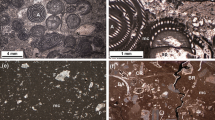Abstract
Limestone and monocrystalline calcite tempers (grains) are abundant in ancient pottery. In pottery from the Canaan area the former is common in Iron Age storage and table-ware vessels and the latter is present in cooking pots. Limestone is much more widespread than monocrystalline calcite and the potters used it often as tempers when manufacturing pottery vessels, but usually not for cooking pots. While defects appear frequently around limestone tempers, they do not appear around monocrystalline calcite ones. This study examines the reason for using the latter tempers rather than the former ones.
Raw materials of carbonate tempers in a clay matrix were fired and the decarbonation process was followed by quantitative IR thermospectrometry. The results indicate that the monocrystalline calcite tempers prevent formation of defects in the cooking pots during firing or during use. The reasons for this are higher thermostability at elevated temperatures, lower intensity of decarbonation, and retention of grain shape, as compared to limestone tempers.
Zusammenfassung
In alten Töpferwaren werden reichlich Kalkstein und monokristalline Kalzitmischungen gefunden. Bei Töpferwaren aus dem Gebiet Canaan ist ersteres bei Vorrats- und Tischgeschirrgefäßen, letzteres bei Kochtöpfen üblich. Kalkstein ist weitverbreiteter als monokristallines Kalzit und es wurde von den Töpfern bei der Fertigung von Töpfereigefäßen oft als Mischung eingesetzt, jedoch nicht für Kochgeschirr. Während Defekte oft an Kalkstein-mischungen auftreten, kommen sie an monokristallinen Kalzitmischungen nicht vor. In dieser Arbeit wird der Grund dafür gesucht, daß die letzteren Mischungen den ersteren vorgezogen wurden.
Rohmaterialien aus Karbonatmischungen wurden in einer Tonmatrix gebrannt und der Dekarbonierungsprozeß mittels IR Thermospektrometrie verfolgt. Die Resultate zeigen, daß monokristalline Kalzitmischungen beim Brennen oder bei der Benutzung die Bildung von Defekten bei Kochgeschirr verhindern. Die Gründe dafür liegen—verglichen mit Kalksteinmischungen—in der höherem Thermostabilität bei erhöhten Temperaturen, in der weniger intensiven Dekarbonierung und in der Beibehaltung der Gefügestruktur.
Similar content being viewed by others
References
N. Porat, In “L'urbanisation de la Palestine à l'age du Bronze Ancien”, P. Miroschedji ed., B. A. R., Oxford 1989.
D. Arnold, “Ceramic Theory and Cultural Process”, Cambridge University Press, Cambridge 1985.
R. C. Mackenzie, “Differential Thermal Analysis” Academic Press, London 1970, 1972.
L. Heller-Kallai, I. Miloslavski and Z. Aizenshtat, Naturwissenschaften, 73 (1986) 615.
L. Heller-Kallai, I. Miloslawski and Z. Aizenshtat, Clay Minerals, 22 (1987) 339.
Y. Deutsch and L. Heller-Kallai, Thermochim. Acta, 182 (1991) 77.
R. C. Mackenzie and A. A. Rahman, Thermochim. Acta, 121 (1987) 51.
R. C. Mackenzie, A. A. Rahman and H. M. Moim, Thermochim. Acta, 124 (1988) 119.
M. Kochavi, Israel Exploration Journal, 39 (1989) 1.
V. C. Farmer, “The Infrared Spectra of Minerals”, Mineralogical Society, London 1974.
S. Shoval, M. Gaft, P. Beck, Y. Kirsh and E. Yadin, Abstract, Israel Geological Society Annual Meeting Proceedings, (1992) 137.
S. Shoval, Thermochim. Acta, 135 (1988) 243.
M. Maciejewski and A. Reller, Thermochim. Acta, 110 (1987) 145.
M. Maciejewski and A. Reller, Thermochim. Acta, 142 (1989) 175.
S. Shoval, P. Beck, Y. Kirsh, D. Eisenberg—Levy and E. Yadin, Abstract, Israel Geological Society Annual Meeting Proceedings, (1992) 136.
S. Shoval, P. Beck, E. Yadin, M. Gaft, Y. Kirsh and D. Eisenberg—Levy, Abstract, Eighteenth Archaeological Conference in Israel Proceedings, Israel Exploration Society, Israel Antiquities Authority, (1992) 35 (in Hebrew)
Author information
Authors and Affiliations
Rights and permissions
About this article
Cite this article
Shoval, S., Gaft, M., Beck, P. et al. Thermal behaviour of limestone and monocrystalline calcite tempers during firing and their use in ancient vessels. Journal of Thermal Analysis 40, 263–273 (1993). https://doi.org/10.1007/BF02546577
Published:
Issue Date:
DOI: https://doi.org/10.1007/BF02546577




